语言学问答题
语言学纲要问答题
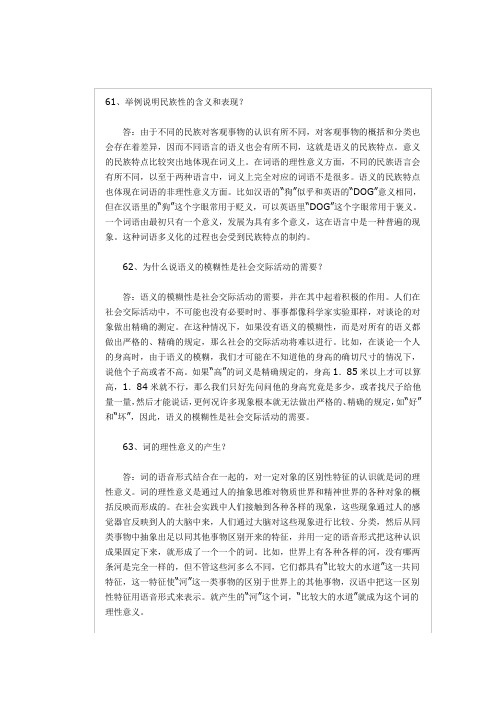
答:应力求做到准确。义素分析的结果必须准确反映词语的所指范围,应能包容而且只包容词义所反映的那类对象,不能过宽,不能过窄,在准确的前提下,义素分析还应力求简明。义素分析的设想是要以一套数量有限的语义成分来描写整个词义系统,因而在分析过程中,应用尽可能少的义素来揭示词义的特征。
67、义素分析的作用?
70、词为什么会由单义发展为多义?
答:词由单义发展为多义是具有其各方面的根源的,首先,客观对象之间的各种相关性和相似性联系是词语多义化的现实基础。由于客观事物间具有这种相关性或相似性,在使用语言的过程中,人们就有可能根据客观对象之间的某种关联,用指称甲类对象的词去指称乙类对象,从而产生出与原来的词义有联系的新的意义。比如英语的“pen”本来是“羽毛”的意思,由于古代用羽毛蘸墨水写字,羽毛便和书写工具联系在一起,人们用同一贯词去指称这两个虽不同但又有联系的事物,就使“pen”增加了“笔”的意思。其次,词语的多义化是语言经济原则的必然产物。语言中的语音形式总是有限的,而随着社会的发展和人的认识的深化,语言要表达的意义又总是不断增加的,用数量有限的语言形式去表达数量庞大且不断增加的意义,就必然会出现一个语音形式表达多个意义的多义化现象。
78、简要说明音符最初都是由已有的意符转化而来的?
答:意符就是文字系统中的字符跟文字所代表的语言单位在意义上有联系的字符,也就是表意的字符。文字系统中的字符跟文字所代表的语言单位在语音上有联系的字符就是音符,也就是表音的字符。但是语音没法由图形来表示,因此音符最初都是由已有的意符转化而来的,例如古汉字的“其”原来是“簸箕”的意思,原本是一个意符,后来采用这个字的字音去记录同音的虚词“其”,“簸箕”的意思就抛开了不管了,在这种情况下,“其”就是成了只在语音上跟有关的语言单位有联系的音符。
语言学问答题
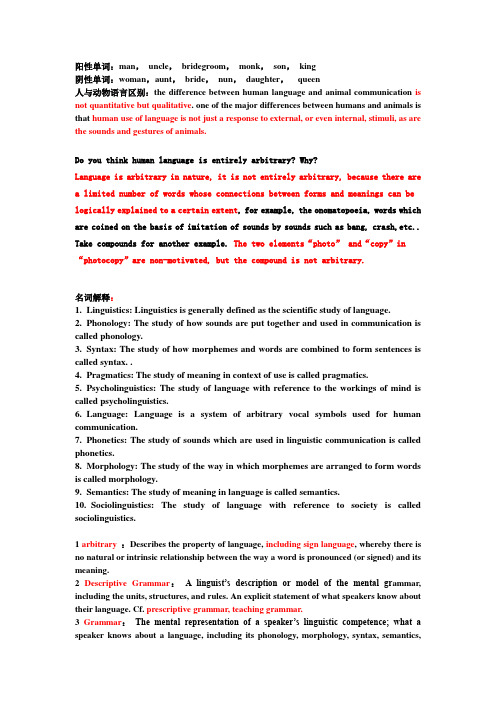
阳性单词:man,uncle,bridegroom,monk,son,king阴性单词:woman,aunt,bride,nun,daughter,queen人与动物语言区别:the difference between human language and animal communication is not quantitative but qualitative. one of the major differences between humans and animals is that human use of language is not just a response to external, or even internal, stimuli, as are the sounds and gestures of animals.Do you think human language is entirely arbitrary? Why?Language is arbitrary in nature, it is not entirely arbitrary, because there are a limited number of words whose connections between forms and meanings can be logically explained to a certain extent, for example, the onomatopoeia, words which are coined on the basis of imitation of sounds by sounds such as bang, crash,etc.. Take compounds for another example. The two elements“photo” and“copy”in “photocopy”are non-motivated, but the compound is not arbitrary.名词解释:1. Linguistics: Linguistics is generally defined as the scientific study of language.2. Phonology: The study of how sounds are put together and used in communication is called phonology.3. Syntax: The study of how morphemes and words are combined to form sentences is called syntax. .4. Pragmatics: The study of meaning in context of use is called pragmatics.5. Psycholinguistics: The study of language with reference to the workings of mind is called psycholinguistics.6. Language: Language is a system of arbitrary vocal symbols used for human communication.7. Phonetics: The study of sounds which are used in linguistic communication is called phonetics.8. Morphology: The study of the way in which morphemes are arranged to form words is called morphology.9. Semantics: The study of meaning in language is called semantics.10. Sociolinguistics: The study of language with reference to society is called sociolinguistics.1 arbitrary:Describes the property of language, including sign language, whereby there is no natural or intrinsic relationship between the way a word is pronounced (or signed) and its meaning.2 Descriptive Grammar: A linguist’s description or model of the mental gr ammar, including the units, structures, and rules. An explicit statement of what speakers know about their language. Cf. prescriptive grammar, teaching grammar.3 Grammar:The mental representation of a speaker’s linguistic competence; what a speaker knows about a language, including its phonology, morphology, syntax, semantics,and lexicon. A linguistic description of a speaker’s mental grammar.4lexicon:The component of the grammar containing speakers’ knowledge about morphemes and words; a speaker’s mental dictionary.5 morphology:The study of the structure of words; the component of the grammar that includes the rules of word formation.6 Phonology:The sound system of a language; the component of a grammar that includes the inventory of sounds (phonetic and phonemic units) and rules for their combination and pronunciation; the study of the sound systems of all languages.7Semantics:The study of the linguistic meaning of morphemes, words, phrases, and sentences.8 sign languages:The languages used by deaf people in which linguistic units such as morphemes and words as well as grammatical relations are formed by manual and other body movements.9syntax :The rules of sentence formation; the component of the mental grammar that represents speake rs’ knowledge of the structure of phrases and sentences.10 Universal Grammar(UG) :The innate principles and properties that pertain to the grammars of all human languages.11 aspirated:Describes a voiceless stop produced with a puff of air that results when the vocal cords remain open for a brief period after the release of the stop, e.g., the [ph] in pit. Cf. unaspirated.12 diacritics:Additional markings on written symbols to specify various phonetic properties such as length, tone, stress, nasalization; extra marks on a written character that change its usual value, e.g., the tilde [~] drawn over the letter n in Spanish represents a palatalized nasal rather than an alveolar nasal.13 glottis:The opening between the vocal cords.14 International Phonetic Association (IPA):The organization founded in 1888 to further phonetic research and develop the International Phonetic Alphabet.15 manner of articulation:The way the airstream is obstructed as it travels through the vocal tract. Stop, nasal, affricate, and fricative are some manners of articulation. Cf. place of articulation.16 phonetics:The study of linguistic speech sounds, how they are produced (articulatory phonetics), how they are perceived (auditory or perceptual phonetics), and their physical aspects (acoustic phonetics).17 stressed syllable : A syllable with relatively greater length, loudness, and/or higher pitch than other syllables in a word, and therefore perceived as prominent. Also called accent.18 tone: Contrastive pitch of syllables in tone languages in which two words may be identical except for such differences in pitch, e.g., in Thai [naa] with falling pitch means ―face,‖ but with a rising pitch means ―thick.‖ Cf. register tones, contour tones.19complementary distribution: The situation in which phones never occur in the same phonetic environment, e.g., [p] and [ph] in English. Cf. allophones.20 free variation:Alternative pronunciations of a word in which one sound is substituted for another without changing the word’s meaning, e.g., pronunciation of bottle as [batEl] or [ba/El].21 intonation:Pitch contour of a phrase or sentence.22 length:A prosodic feature referring to the duration of a segment. Two sounds may contrast in length, e.g., in Japanese the first vowel is [+ long} in /biiru/ ―beer‖ but [– long], therefore short, in /biru/ ―building.‖23 minimal pair (or set):Two (or more) words that are identical except for one phoneme that occurs in the same position in each word, e.g., pain /pen/, bane /ben/, main /men/.24 phonetic features:Phonetic properties of segments (e.g., voice, nasal, alveolar) that distinguish one segment from another.25 acronym:Word composed of the initials of several words, e.g., PET scan from positron-emission tomography scan.26 compound :A word composed of two or more words, e.g., washcloth, childproof cap.27 form:Phonological or gestural representation of a morpheme or word.28:meaning:The conceptual or semantic aspect of a sign or utterance that permits us to comprehend the message being conveyed. Expressions in language generally have both form — pronunciation or gesture — and meaning. Cf. extension, intension, sense, reference.29 morpheme:Smallest unit of linguistic meaning or function, e.g., sheepdogs contains three mor30 morphological rules:Rules for combining morphemes to form stems and words.31 open class:The class of lexical content words; a category of words that commonly adds new words, e.g., nouns, verbs.32 orthography:The written form of a language; spelling.33 complemen t;The constituent(s) in a phrase other than the head that complete(s) the meaning of the phrase. In the verb phrase found a puppy, the noun phrase a puppy is a complement of the head verb found.34 deep structure;Any phrase structure tree generated by the phrase structure rules of a transformational grammar. The basic syntactic structures of the grammar.35 direct object;The grammatical relation of a noun phrase when it appears immediately below the verb phrase (VP) and next to the verb in deep structure; the noun phrase complement of a transitive verb, e.g., the puppy in the boy found the puppy.36 functional category;One of the categories of function words, including determiner, aux, complementizer, and preposition. These categories are not lexical or phrasal categories. Cf. lexical categories, phrasal categories.37 phrase structure tree;A tree diagram with syntactic categories at each node that reveals both the linear and hierarchical structure of phrases and sentences.38 rules of syntax;Principles of grammar that account for the grammaticality of sentences, their hierarchical structure, their word order, whether there is structural ambiguity, etc. Cf. phrase structure rules, transformational rules.39 structure dependent;(1) A principle of Universal Grammar that states that the application of transformational rules is determined by phrase structure properties, as opposed to structureless sequences of words or specific sentences; (2) the way children construct rules using their knowledge of syntactic structure irrespective of the specific words in the structure or their meaning.40 surface structure:The structure that results from applying transformational rules to a deep structure. It is syntactically closest to actual utterances. Cf. transformational rule.41 transformational rule, transformation:A syntactic rule that applies to an underlyingphrase structure tree of a sentence (either deep structure or an intermediate structure already affected by a transformation) and derives a new structure by moving or inserting elements, e.g., the transformational rules of wh movement and do insertion relate the deep structure sentence John saw who to the surface structure Who did John see.42 coreferential:Describes noun phrases (including pronouns) that refer to the same entity.43 heteronyms:Different words spelled the same (i.e., homographs) but pronounced differ ently, e.g. bass, meaning either ―low tone‖ [bes] or ―a kind of fish‖ [bœs].44 homographs:Words spelled identically, and possibly pronounced the same, e.g., bear meaning ―to tolerate,‖ and bear the animal; or lead the metal and lead, what leaders do.45 hyponyms:Words whose meanings are specific instances of a more general word, e.g., red, white, and blue are hyponyms of the word color; triangle is a hyponym of polygon.46 lexical semantics:The subfield of semantics concerned with the meanings of words and the meaning relationships among words.47 pragmatics:The study of how context and situation affect meaning.48 semantic features:A notational device for expressing the presence or absence of semantic properties by pluses and minuses, e.g., baby is [+ young], [+ human], [– abstract], etc.49 semantic properties:The components of meaning of a word,e.g., ―young‖ is a semantic property of baby, colt, puppy.。
语言学:汉语修辞学试题及答案

语言学:汉语修辞学试题及答案1、问答题什么是言辞选择,它有什么内涵?正确答案:言辞选择:词语的选择,既包括词的选择,也包括短语的选择。
不仅只是选择运用现成的词语,还包括改造运用某些词语,这种改造运用时对词与短(江南博哥)语创造性的选择,是一种为追求特殊表达效果的变异性运用。
2、单选“国破山河在”这首诗属于近体诗中的OoA.平起平收B.平起仄收C.仄起平收D.仄起仄收正确答案:D3、多选下列句子,表达不恰当的有OoA、暑假里,爸爸陪同我去黄山玩,爬天都峰。
B、随着教育事业的发展和需要,一支庞大的教师队伍已逐渐形成。
C、程老师的一番话,好像一股强大的暖流,流到我的心田。
D、上课以前,班主任就把王老师生病的新闻告诉了同学们。
正确答案:A,B,D4、多选语言锤炼的基本要求是OoA、准确朴实B、简洁有力C、新鲜活泼D、生动形象正确答案:A,B,C,D5、问答题普通话四声中,哪些是平声,哪些是仄声?平声和仄声各有什么特点?合理安排平仄有什么修辞效果?正确答案:平声包括普通话中的阴平和阳平,仄声包括普通话中的上声和去声。
平声的特点是长而扬,仄声的特点是短而抑。
平仄安排得当,声调平衡交替,声音显得错落有致,节奏分明,具有抑扬美。
6、多选下列各句在成语运用中不够恰当的是OA、她这个人清高自负,对那些衣着豪华、佩金戴银、显得美轮美奂的“贵妇人”总是看不顺眼。
B、那个黄头发的青年见魏不肯拿钱,便气极败坏地抢下出租车钥匙,来搜魏的衣袋。
C、她比大家大一点,深受大家的敬重。
平时店主任在,她是营业员;店主任不在,她就代理主任的工作。
主任回店,她又心安理得地回到助手的位置。
D、巴拿马运河终于物归原主。
正确答案:A,B,C7、问答题简述什么是移情并举例说明。
正确答案:1、移情:为了抒发强烈的感情,作者使周围的物体染上一层与自己情感一致,但实际不存在的感情色彩的修辞方式叫移情。
移情就是把人的思想感情转移到物身上的修辞方式。
2、例如:“蜡烛有心还惜别,替人垂泪到天明。
语言学:语言学概论必看题库知识点四

语言学:语言学概论必看题库知识点四1、单选关于社会方言的形成,下列说法不正确的一项是()A.社会方言大多是在语言的相互接触中形成的B.社会方言是随着社会的社群分化而产生的C.一种语言的内部有可能形成社会(江南博哥)方言D.一种方言的内部有可能形成社会方言正确答案:A2、问答题简答音位和音位变体的关系。
正确答案:音位是从具体音素中抽象概括出来的功能音类,音位变体则是音位在特定语音环境中的具体体现。
音位是用来概括反映一组音素的辨义作用的功能单位,音位变体则是音位在各种语音环境里的实际发音。
3、名词解释共时文字学和历时文字学正确答案:共时文字学研究某一时期的文字系统,如现代文字学、现代汉字学、古文字学等。
历时文字学从发展变化的角度研究文字的历时变化,例如文字发展史、汉字发展史等。
4、单选洋泾浜语和克里奥耳语属于语言的()A、语言的借用和吸收B、语言的转用C、语言的混合D、双语现象正确答案:C参考解析:在不同语言频繁接触的地区,来源于不同语言的成分可能混合在一起,产生了洋泾浜语和克里奥耳语。
母语化了的洋泾浜语就成了克里奥耳语。
5、名词解释中介语现象正确答案:中介语现象指在外语学习过程中,学习者建立的一种既不同于母语又不同于外语而只属于个人的语言系统。
6、单选一种语言中数量最少的是()A、音素B、音位C、语素D、音节正确答案:B7、问答题简要说明音质音位和非音质音位的区别?正确答案:音质音位是以音素为材料,通过音质的差别来起辨义作用的音位。
因为说话时产生的连续语流总占据一定的时间,音质单位在语音组合的线性序列中都各自占有一个时间段落。
所以音质音位又叫做“音段音位”。
而非音质音位是通过音高、音强、音长的差别来起辨义作用的音位,因为它所依附的并不局限于一个音段音位,而且常常依附在音段音位的组合序列上,因此非音质音位又叫做“超音段音位”。
8、单选下列各组词,吸收外来成分的手段存在不一致情况的一组是()A.丹麦挪威法兰西B.沙拉咖啡麦当劳C.卡车啤酒立邦漆D.香波克隆好莱坞正确答案:D9、单选从词的构造方式看,下列各项中属于复合词的是()A.木头B.念头C.苦头D.山头正确答案:D10、名词解释社会现象正确答案:指那些与人类共同体的一切活动--产生、存在和发展密切联系的现象。
(完整word版)语言学名词解释和问答题答案(只供参考)
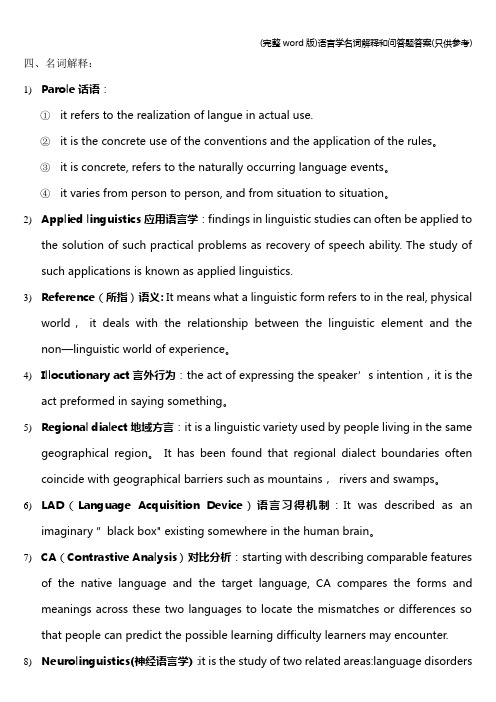
四、名词解释:1)Parole话语:①it refers to the realization of langue in actual use.②it is the concrete use of the conventions and the application of the rules。
③it is concrete, refers to the naturally occurring language events。
④it varies from person to person, and from situation to situation。
2)Applied linguistics应用语言学:findings in linguistic studies can often be applied tothe solution of such practical problems as recovery of speech ability. The study of such applications is known as applied linguistics.3)Reference(所指)语义: It means what a linguistic form refers to in the real, physicalworld,it deals with the relationship between the linguistic element and the non—linguistic world of experience。
4)Illocutionary act言外行为:the act of expressing the speaker’s intention,it is theact preformed in saying something。
5)Regional dialect地域方言:it is a linguistic variety used by people living in the samegeographical region。
语言学问答题

Chapter 14. Do you think that onomatopoeia indicates a non-arbitrary relationship between form and meaning?Answer:No matter you say "Yes" or "No", you cannot deny that onomatopoeia needs arbitrariness. Before we feel a word is onomatopoeic we should first know which sound the word imitates. Just as what is said in Chapter One, in order to imitate the noise of flying mosquitoes, there are many choices like "murmurous" and "murderous". They both bear more or less resemblance to the genuine natural sound, but "murmurous" is fortunately chosen to mean the noise while "murderous" is chosen to mean something quite different. They are arbitrary as signifiers.6. Does the traffic light system have duality? Can you explain by drawing a simple graph?Answer:Traffic light does not have duality. Obviously, it is not a double-level system. There is only one-to-one relationship between signs and meaning but the meaning units cannot be divided into smaller meaningless elements further. So the traffic light only has the primary level and lacks the secondary level like animals’ calls. Red→stop Green→go Yellow→get ready to go or stop10. What do you think of Bertrand Russell’s observation of the dog language: “No matter how eloquently a dog may bark, he cannot te ll you that his parents were poor but honest”? Are you familiar with any type of ways animals communicate among themselves and with human beings?Answer:When gazelles sense potential danger, for example, they flee and thereby signal to other gazelles in the vicinity that danger is lurking. A dog signals its wish to be let inside the house by barking and signals the possibility that it might bite momentarily by displaying its fangs.13. Comment on the following prescriptive rules. Do you think they are acceptable?(A) It is I.(B) It is me.You should say A instead of B because “be” should be followed by the nominative case, not the accusative according to the rules in Latin.Answer:(1) the Latin rule is not universal. In English, me is informal and I is felt to be very formal.(2) Whom is used in formal speech and in writing; who is more acceptable in informal speech.(3) Language does not have to follow logic reasoning. Here two negative only make a more emphatic negative. This sentence is not acceptable in Standard English not because it is illogical, but because language changes and rejects this usage now.17. The following are some well-known ambiguous sentences in syntactic studies of language. Can you disambiguate them?The chicken is too hot to eat.Flying planes can be dangerous.Answer:The chicken is too hot to eat.The chicken meat is too hot, so it cannot be eaten at the moment.The chicken feels so hot (maybe after some intense aerobic exercises) that it cannot start eating and needs to calm down first.Flying planes can be dangerous.The ambiguity comes from "flying planes". It can be deciphered as "the planes that is flying" or "to fly planes". 21. Give examples of situations in which a usage generally considered non-standard (e.g. ain’t) would be acceptable, even appropriate.Answer:In the talks between intimate friends, one may say “gimme that!” instead of “give me that!” and “wachya doin’?” instead of “what are you doing?” and this list may go on.Chapter 22、Give the description of the following sound segments in English.Answer:ʃ——voiceless postalveolar fricativeð——voiced dental fricativeŋ——velar nasald——voiced alveolar stop/plosivep——voiceless bilabial stop/plosivek——voiceless velar stop/plosivel——laterali——high front unrounded lax vowelu: p—— high back rounded tense vowelɔ——low back rounded lax vowel3、Give the IPA symbols for the sounds that correspond to the descriptions below.Answer:Voiceless labiodental fricative——fVoiced postalveolar fricative——ʒPalatal approximant ——jVoiceless glottal fricative——hVoiceless alveolar stop——tHigh-mid front unrounded vowel——eHigh central rounded vowel——uLow front rounded vowel——ðLow-mid back rounded vowel——ɔHigh back rounded tense vowel——u:5、Discuss the following questions.To what extent is phonology related too phonetics and how do they differ? Answer:Both phonetics and phonology study human sounds but they differ in the levels of analysis.Phonetics studies how speech sounds are produced,transmitted,and perceived.Chapter 310、Classfy the following words as loanwords(LW),loanblends(LB),loanshifts(LS)or loan translation(LT). Answer:LW:monk,loan-word,tea LB:booby trap,coconut,ChinatownLS:yankee,artificial,satellite LT:firewater,free verse,warpaint11、If there are two affixes-ly,one producing adjectives and the other attaching to adjectives to produce adverbs,can we find words with both of these affixes?Answer:No.Words with both of these affixes-ly are not allocated in English.See below:Friendlily(friend-friendly-friendlily) Oilily(oil-oily-oilily)Chillily(chill-chilly-chillily)12、Make a list of nouns from the following words that-s can attch to.Epiphany foot hat house Kitchen ox phenomenon region sheep tomatoAnswer: hat house kitchen regionChapter 42、Indicate the category of each word in the following sentences.Answer:——The instructor told the students to study. [NP(det.+n)+V+NP(det.+n)+inf.]——The customer requested for a cold beer.[ NP(det.+n)+V+PP(prep.+det.+adj.+n.)]——The pilot landed the jet.[ NP(det.+n)+V+NP(det.+n)]——These dead trees must be removed.[ NP(det.+adj+n)+mv+be+past participle) ]——That glass suddenly broke.[ NP(det.+n)+adv.+V]3、Put brackets around the immediate constituents in each sentence.Answer:——((The)( boy))(( was)) crying)).——(Shiu)(( the)( door)).——((Open)(( the)( door)))( quickly).——((The)((( happy)( teacher))(( in)(( that)( class)))))(( was)(( beaming)( away))).——(He)((( bought)(( an)(( old)( car))))(( with)(( his)(( first)(( pay)( cheque)))))).4、For each of the underlinged constructions or word groups,do the following.Answer:——Duceks quack..(non-headed;independent clause)——The ladder in the shed is long enough.( non-head;prepositional phrase)——I saw a bridge damaged beyond repair.(headed;headword—damaged;adjectival group)——Singing hymns is forbidden in some countries.(headed;headword—singing;gerundial phrase)——His handsome face appeared in the magazine.( headed; headword—face;nominal group)A lady of great beauty came out.( (non-headed; prepositional phrase)——He enjoys climbing high mountains.(headed;headword—climbing;gerundial phrase)——The man nodded patiently.(non—headed;independent clause)——A man roused by the insult drew his sword.(headed;headword—roused;adjectveal phrase)8、Mark the underlined parts of the sentences in Ex.4-37 with the terms such as participial phrase,gerundial,and so on.Answer:The best thing would be to leave early.It’s great for a man to be free.Having finished their task,they came to help ue.Xiao Li being away,Xiao Wang had to do the work.Filled with shame,he left the house.All our savings gone,we started looking for jobs.It’s no use crying over spilt milk.Do you mind my opening the window.Chapter 5[ Dear White Fella. You White Fella ]Answer:This poem is about the use of the word“coloured”.The author cleverly makes use of “coloured”in sense of “different colours”to qppose the practive to refer to black people as “coloured”. This shows form another point of view that “coloured” is not a superordinate to “red”, “green”, “yellow”.[ Write out the synonyms of the following words: youth; automobile; remember; purchase; vacation; big.] Answer:(a)youth(adolescent);automobile(car);remember(recall);purchase(buy);vacation(holidays);big(large)(b)dark(lignt: with respect to brightness)boy(girl: with respect to sex)hot(cold: with respect to temperature)go(come:with respect to direction)(c)bright(a,shining;b.intelligent)To glare(a. to shine intensely; b.money in the bank)A deposit(a.minerals in the earth; b.money in the bank)Plane(a. aflying vehicle; b. a flat surface)[ The British linguist F.R Palmer argues in his Semantics that “there”is no absolute distinction between (gradable antonyms and complementary sntonyms).]Answer: I t is not advisable to tell beginners of linguistics thar the distinction between gradable antonyms and complementary antonyms is relative. The expression “more dead than alive” is not a true comparative.[ 姜望琪(1991:79)claims that“to some extent, we can say that a ny two words of the same part of speech may become antonyms.. what do you think of the claim?]Answer: this is a reasonable claim. As the author said in the paper.“man” can be the antonym of “woman”, but it can also be the antonym of“boy” in a situation wh en the age difference is important. When the difference between a man and an animal is important,“man” can also be the antonym of“dog”. And when the difference between something animate and something inanimate is important, then“man” can even be the antonym of “stone”. In the extreme cases, so-called synonyms may also become antonyms, for example,“ You have to peel a raw potato but you can skin a boiled one”,“He’s no statesman, but a mere politician.Chapter 8[ The daughter walks into the kitchen and takes some popcorn. ]Answer:The illocutionary force of“I thought you were practicing your violin”is a criticism of the daughter for her not practicing the violin .That of the daughter’s answer is a defence for herslf-I’m going to do that. And that of the f ather’s retort is a denial of the daughter’s excuse.[ If you ask somebody“Can you open the door?”he answers“Yes”…]Answer:I would be angry with him.“Can you open the door”is normally a request of the hearer to do it rather than a question about his abil ity. The fact that he answers“Yes”but does not actually do it shows that he declines my request.[ On 14 January,1993,US President-elect Bill Clinton spoke to…]Answer:Yes, this is an occasion on which the CP and its maxims are suspended.When he formulated his CP, Grice qualified it with expressions like “normally”,“characteristically”and“ceteris paribus”.InOther words ,the CP and its maxims are not meant to be observed in all situations. Alternatively, we may say that assumptions like“The speaker believes in what he says”are implicatures, which will be cancelled in situations where there are indications to the contrary. Similar occasions include funeral orations, poetry writing, and joking.[ A:Have you seen Peter today?B:Well, if I didn’t deny seeing him I wouldn’t be telling a lie.]Answer:Without a proper context, these conversations can all be regarded as jokes resulting form the exploitation of Grice’s CP and maxims.In(1) Speaker B uses a long and prolix way to express the meaning of“Yes, I have”, thus violating the Manner maxim of “Be brief(avoid prolixity)”.(2B) results from the exploiting of Quality maxims in that the speaker seems to be telling the truth while deliberately misinterpreting Speaker A’s “there”.(3B) is another instance of exploiting the Quality maxims. Though logically speaking it may be true that Speaker B has been helpful to A,we don’t usually respond to others’ thanks in this way.On one hand,(4B) is still another instance of exploiting the Quality maxims in that Mr Smith’s office is really“not here”.On the other hand, Speaker B as violated the Quantity maxim of being as informative as is required since A needs more specific information than“not here”.(5B) is an indirect way of declining the offer. In terms of Grice’s maxims, this is a case of not being relevant.In the last conversation, Speaker B uses a long prolix way for the simple answer“Yes, he has”,and has thus violated the Manner maxim of “Be brief(avoid prolixity)”。
语言学考试题
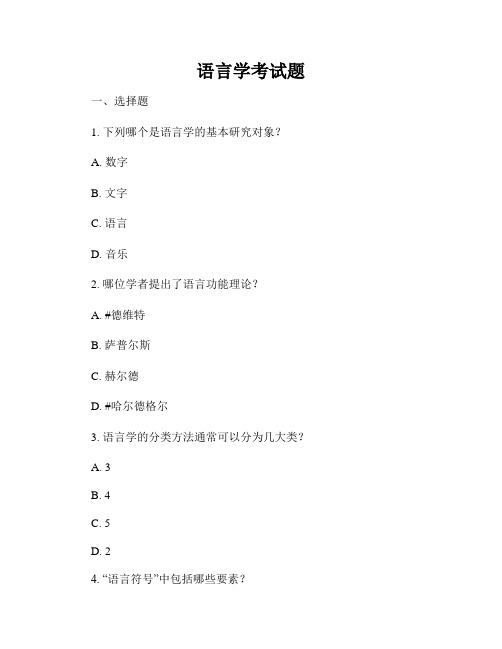
语言学考试题一、选择题1. 下列哪个是语言学的基本研究对象?A. 数字B. 文字C. 语言D. 音乐2. 哪位学者提出了语言功能理论?A. #德维特B. 萨普尔斯C. 赫尔德D. #哈尔德格尔3. 语言学的分类方法通常可以分为几大类?A. 3B. 4C. 5D. 24. “语言符号”中包括哪些要素?A. 声音B. 符号C. 拼写D. A、B5. 在语法范畴中,“动宾关系”是指什么?A. 主语和谓语之间的语法关系B. 主语和宾语之间的语法关系C. 宾语和谓语之间的语法关系D. 主语和动词之间的语法关系二、填空题6. 语言学中研究音素的学科是---。
7. 没有逻辑意义的音节称为---。
8. 语音学的基本单位是---。
9. 下列哪个不是语言学的分支学科?10. 一种语言中声母、韵母和声调三者综合的组合称为---。
三、简答题11. 请简要说明音韵学和语音学的区别。
12. 什么是“方言”,方言和语言的关系是什么?13. 什么是语法,语法的作用是什么?14. “文字和语言的关系”是语言学中一个重要问题,请简述你对这个问题的理解。
15. 请简要介绍语言学的研究方法有哪些?四、论述题16. 语言是人类最重要的交流工具之一,请说明语言对个体和社会的重要性。
17. 语言学的发展历程是怎样的?过去、现在和未来的语言学会有怎样的发展趋势?18. 请解释语言与文化之间的关系,并谈谈语言多样性对世界文化的重要影响。
以上便是本次语言学考试题的全部内容,请同学们认真地完成每一道题目,祝大家取得优异的成绩!。
(完整word版)语言学名词解释和问答题答案(只供参考)
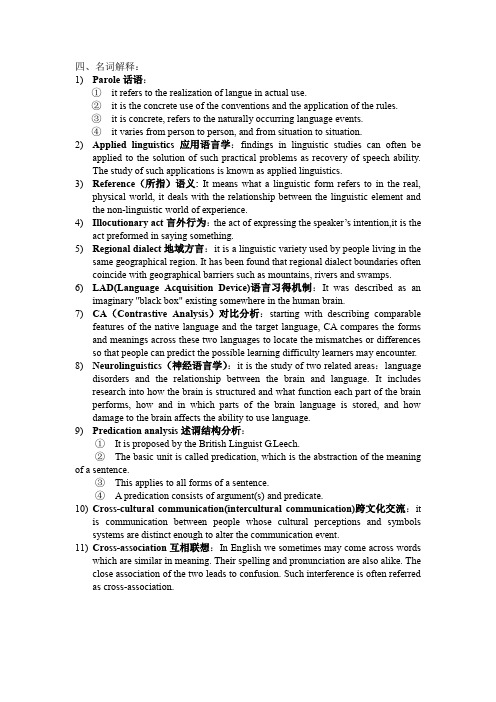
四、名词解释:1)Parole话语:①it refers to the realization of langue in actual use.②it is the concrete use of the conventions and the application of the rules.③it is concrete, refers to the naturally occurring language events.④it varies from person to person, and from situation to situation.2)Applied linguistics应用语言学:findings in linguistic studies can often beapplied to the solution of such practical problems as recovery of speech ability.The study of such applications is known as applied linguistics.3)Reference(所指)语义: It means what a linguistic form refers to in the real,physical world, it deals with the relationship between the linguistic element and the non-linguistic world of experience.4)Illocutionary act言外行为:the act of expressing the speaker’s intention,it is th eact preformed in saying something.5)Regional dialect地域方言:it is a linguistic variety used by people living in thesame geographical region. It has been found that regional dialect boundaries often coincide with geographical barriers such as mountains, rivers and swamps.6)LAD(Language Acquisition Device)语言习得机制:It was described as animaginary "black box" existing somewhere in the human brain.7)CA(Contrastive Analysis)对比分析:starting with describing comparablefeatures of the native language and the target language, CA compares the forms and meanings across these two languages to locate the mismatches or differences so that people can predict the possible learning difficulty learners may encounter.8)Neurolinguistics(神经语言学):it is the study of two related areas:languagedisorders and the relationship between the brain and language. It includes research into how the brain is structured and what function each part of the brain performs, how and in which parts of the brain language is stored, and how damage to the brain affects the ability to use language.9)Predication analysis述谓结构分析:①It is proposed by the British Linguist G.Leech.②The basic unit is called predication, which is the abstraction of the meaning of a sentence.③This applies to all forms of a sentence.④ A predication consists of argument(s) and predicate.10)Cross-cultural communication(intercultural communication)跨文化交流:itis communication between people whose cultural perceptions and symbols systems are distinct enough to alter the communication event.11)Cross-association互相联想:In English we sometimes may come across wordswhich are similar in meaning. Their spelling and pronunciation are also alike. The close association of the two leads to confusion. Such interference is often referred as cross-association.12)CPH(Critical Period Hypothesis)临界期假说:a specific and limited time period for language acquisition.①The strong version of CPH suggests that children must acquire their first language by puberty or they will never be able to learn from subsequent exposure.②The weak version holds that language learning will be more difficult and incomplete after puberty. (Support in Victor’s and Genie’s cases)13) Prescriptive(grammer)规定语法:if the linguistic study aims to lay down rules for "correct and standard " behaviour in using language to ell people what they should say and what they should not say, it is said to be prescriptive.14) Performance语言运用;言语行为:the actual realization of this knowledge in linguistic communication .15)Duality双重性(double articulation):language is a system, which consists of two sets of structures, or two levels. The lower or basic level is of sounds, which are meaningless. The higher level can be meaningful.五、问答题:Chapter 11.How do you interpret the following definition of linguistics: linguistics is the scientificstudy of language?Linguistics studies not any particular language,but it studies languages in general.It is a scientific study because it is based on the systematic investigation of linguistic data,conducted with reference to some general theory of language structure.In order to discover the nature and rules of the underlying language system, what the linguist has to do first is to collect and observe language facts,which are found to display some similarities ,and generalizations are made about them,then he formulates some hypotheses about the language structure .But the hypotheses thus formed have to be checked repeatedly against the observed facts to fully prove their validity.6. How is Saussure’s distinction between langue and parole similar to Chomsky’sdistinction between competence and performance?Both Saussure and Chomsky make the distinction between the abstract language system and the actual use of language. their purpose is to single out the language system for serious studyThey are similar in two aspects: the definition and the content of study.On one hand, Saussure defines langue as the abstract linguistic system shared by all themembers of a speech community, and parole as the realization of langue in actual use.Chomsky defines competence as the ideal user’s knowledge of the rules of his language, and performance the actual realization of this knowledge in linguistic communication. We can see that langue and competence both refer to the abstract issue, conventions and knowledge, and parole and performance both are their actual realization, the concrete use.On the other hand, in Saussure’s opinion, what linguists should do is to abstract langue from parole as parole is too varied and confusing. And this is the same as Chomsky. He thinkslinguists should study t he ideal speaker’s competence, not his performance, which is too haphazard to be studied.Two linguists idea differ in that Saussure took a sociological view of language, Chomsky looks at language from a psychological point of view, competence is a property of the mind of each individual.8.What are the main features of human language that have been specified by C.Hockettto show that it is essentially different from animal communication system?1)Arbitrariness:this means that there is no logical connection between meanings andsounds. A good example is the fact that different sounds are used to refer to the same object in different language.2)Productivity:Language is productive in that it makes possible the construction andinterpretation of new signals of its users.3)Duality:language is a system, which consists of two sets of structures, or two levels. Atthe lower or the basic level there is a structure of sounds, which are meaningless. But the sounds of language can be grouped and regrouped into a large number of units of meaning, which are found at the higher level of the system.4) Displacement: Language can be use to refer to things which are present or not present, realor imagined matters in the past ,present or future, or in far-away places. In other words, language can be used to refer to contexts removed from the immediate situations of the speaker.5) Cultural transmission:Language is passed on from one generation to next through teachingand learning rather than by instinct.Chapter 23.Explain with examples how broad transcription and narrow one transcription differ? Broad transcription—one letter symbol for one sound.Narrow transcription—diacritics are added to the one-letter symbols to show the finer differences between sounds.In broad transcription, the symbol [l] is used for the sound [l]8.what’s a phone? how is it different from a phoneme? how are allophones related to a phoneme?① A phone is a phonetic unit or segment. The speech sounds we hear and produce during linguistic communication are all phones. Phones do not necessarily distinguish meaning, some do, some don’t, e.g. [ bI:t ] & [ bIt ], [spIt] & [spIt].② A phoneme is a phonological unit; it is a unit of distinctive value; an abstract unit, not a particular sound, but it is represented by a certain phone in certain phonetic context, e.g. the phoneme /p/ can be represented differently in [pIt], [tIp] and [spIt].③Allophone—the phones that can represent a phoneme in different phonetic environmentsPhone is different from phoneme,The phoneme /l/ can be realized as dark/l-/and clear/l/,which are allophones of the phoneme /l/1.What are the major views concerning the study of meaning?1)The naming theory命名论was proposed by the ancient Greek scholar Plato. Thelinguistic forms or symbols, in other words, the words used in a language are taken to be labels of the objects they stand for; words are just names or labels for things. The semantic relationship holding between words and things is the relationship of naming.2)The conceptualist view概念论: This view holds that there is no direct link between alinguistic form and what it refers to; rather, in the interpretation of meaning they are linked through the mediation of concepts in the mind. This is best illustrated by the semantic triangle suggested by Ogden and Richards:3)Contextualism语境论: Representatively proposed by the British linguist J. R. Firthwho had been influenced by the Polish anthropologist Malinowski and the German philosopher Wittgenstein.It holds that meaning should be studied in terms of situation, use, context-elements closely linked with language behavior. …the meaning of a word is its use in the language.4)Behaviourism行为主义论: Based on contextualist view by Bloomfield who drew onbehaviorist psychology in defining “meaning”.Behaviorists attempted to define the meaning of a language from as the “situation in which the speaker utters it and the response it calls forth in the hearer.” This theory, somewhat close to contextualism, is linked with psychological interest.6.In what way is componential analysis similar to the analysis of phonemes into distinctive features?成分分析和把音位分析为区别性特征有何相似之处?In the light of componential analysis, the meaning of a word consists of a number of distinctive meaning features, the analysis breaks down the meaning of the word into these features; it is these different features that distinguish word meaning similarly, a phoneme is considered as a collection of distinctive sound features, a phoneme can be broken down into these distinctive sound features and its these sound features that distinguish different sounds.5. According to Austin, what are the three acts a person is possibly performing while making an utterance. Give an example.According to Austin's new model, a speaker might be performing three acts simultaneously when speaking: locutionary act, illocutionary act, and perlocutionary act.A locutionary act is the act of uttering words, phrases, clauses. It is the act of conveying literal meaning by means of syntax, lexicon and phonology. An illocutionary act is the act of expressing the speaker’s intention; it is the act performed in saying something. A perlocutionary act is the act performed by or resulting from saying something; it is the consequence of, or the change brought about by the utterance; it is the act performed by saying something. Let's look at an example:"You have left the door wide open."The locutionary act performed by the speaker is his utterance of the wo rds “you”, “have”, “door”,“open”, etc. thus expressing what the words literally mean.The illocutionary act performed by the speaker is that by making such an utterance he has expressed his intention of speaking, i.e. asking someone to close the door, or making a complaint, depending on the context.The perlocutionary act refers to the effect of the utterance. If the hearer gets the speaker's message and sees that the speaker means to tell him to close the door, the speaker has successfully brought about the change in the real world he has intended to; then the perlocutionary act is successfully performed.8. What are the four maxims of the CP? Try to give your own examples to show how floutingthese maxims gives rise to conversational implicature?答:Cooperative Principle, abbreviated as CP. It goes as follows:Make your conversational contribution such as required at the stage at which it occurs by the accepted purpose or direction of the talk exchange in which you are engaged.To be more specific, there are four maxims under this general principle:(1) The maxim of quantity数量原则E.g. A: When is Susan's farewell party?B: Sometimes next month.It is flouting the maxim of quantity(2) The maxim of quality质量原则E.g. A: Would you like to join us for the picnic on Sunday?B: I'm afraid I have got a class on Sunday.(3) The maxim of relation相关原则E.g. A: How did the math exam go today, Tom?B: We had a basketball match with the other class.(4) The maxim of manner方式准则E.g. A: Shall we got something for the kids?B: Yes. But I veto I-C-E-C-R-E-A-M.Chapter92.What do you think of Sapir-Whorf hypothesis? Give examples or proof to support your point of view.Sapir-Whorf believe that language filters people's perception and the way they categorize their experiences. This interdependence of language and thought is now known as Sapir-Whorf Hypothesis. There are mainly two different interpretations about Sapir-Whorf Hypothesis: a strong version and a weak one. The strong version believes that language patterns determine people’s thinking and behavior, the weak one holds that the former influences the later.I agree with the weak one. Here is an example, the word snow. For Eskimo snow is extremely important and so crucial to life that each of its various forms and conditions is named. In English-speaking cultures, snow is far less important and simple word snow usually suffices the need. When some needs become more specific, however, longer phrases can be made up to meet these needs: “corn snow”, “fine powder snow”, and “drifting snow”.Chapter102.Among the language acquisition theories mentioned in this chapter, which one do you think is more reasonable and convincing? Explain why.1)Behaviourist view---language is behavior ,language learning is simply a matter of imitation and habit formation.In this theory,imitation and practice are preliminary(开始),discrimination (识别)and generalizaition are key to language development.2)An innatist (语法天生主义者)view----In the human brain, there is an imaginary “black box”called Language acquisition device which is said to contain principles that are universal to all language.Children need access to the samples of a natural language to activate the LAD, which enables them to discover his language's structure by matching the innate knowledge of basic grammatical system to that particular ter Chomsky prefer this innate endowment as UG and hold that if children are pre-equipped with UG, then what they have to learn is the ways in which their own language make use of these principles and the variations in those principles which may exist in the particular language they are learning.3) An interactionist(互动主义者)view----language develops as a result of the complex interplay,between the human characteristics of the child and the environment in which child develops.In a word,Behaviorists view sounds reasonable in explaining the routine aspects,the innatist accounts most reasonable in explaining children's acquiring complex system, and the interactionist description convincing in understanding how children learn and use the language appropriately from their environment.Chapter111、To what extent is second language learning similar to first language learning? Can you list some proof from your own learning experience?(please list your own experience.)The studies on the first language acquisition have influenced enormously those on the second language acquisition at both theoretical and pratical levels. Theoretically the new findings and advances in first language acquisition in learning theories and learning process are illuminating in understanding second language acquisition. The techniques used to collect and analyze data in first language acquisition also provide insights and perspectives in the study of second language acquisition. Just as Littlewood summarizes, the first language study has served as a backcloth for perceiving and undrerstanding new facts about second language learning.2.Try to observe yourself and pay attention to your own learning experience, what conclusion can you reach about the role of Chinese in your English learning? On what occasions are you more likely to use or depend on Chinese in learning and using English? Chinese plays an inseparable role in our English learning and people can't afford to ignore it. Hence, the role of Chinese in our English learning is worth careful examination. In addition, English learning have been influnenced by Chinese learning at both theoretical and practical levels.(1)Theoretically, the new findings and advanced in Chinese acquisition especially in learning theories and learning process are illuminate (helping) in understanding English acquisition.(2)The techniques used to collect and analyze data in Chinese learning also provides insights and perspectives in the study of English learning.Occasion: Recent studies have discovered that there are three interacting factors in determining language transfer in second language learning:1)a learner's psychology, how a learner organizes his or her native language;2)a learner's perception of native-target language distance,3)a learner's actual knowledge of the target language.。
语言学纲要问答题及填空题
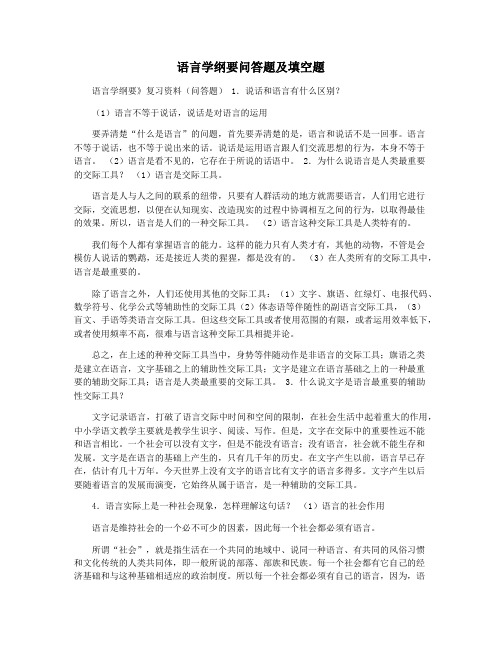
语言学纲要问答题及填空题语言学纲要》复习资料(问答题) 1.说话和语言有什么区别?(1)语言不等于说话,说话是对语言的运用要弄清楚“什么是语言”的问题,首先要弄清楚的是,语言和说话不是一回事。
语言不等于说话,也不等于说出来的话。
说话是运用语言跟人们交流思想的行为,本身不等于语言。
(2)语言是看不见的,它存在于所说的话语中。
2.为什么说语言是人类最重要的交际工具?(1)语言是交际工具。
语言是人与人之间的联系的纽带,只要有人群活动的地方就需要语言,人们用它进行交际,交流思想,以便在认知现实、改造现实的过程中协调相互之间的行为,以取得最佳的效果。
所以,语言是人们的一种交际工具。
(2)语言这种交际工具是人类特有的。
我们每个人都有掌握语言的能力。
这样的能力只有人类才有,其他的动物,不管是会模仿人说话的鹦鹉,还是接近人类的猩猩,都是没有的。
(3)在人类所有的交际工具中,语言是最重要的。
除了语言之外,人们还使用其他的交际工具:(1)文字、旗语、红绿灯、电报代码、数学符号、化学公式等辅助性的交际工具(2)体态语等伴随性的副语言交际工具,(3)盲文、手语等类语言交际工具。
但这些交际工具或者使用范围的有限,或者运用效率低下,或者使用频率不高,很难与语言这种交际工具相提并论。
总之,在上述的种种交际工具当中,身势等伴随动作是非语言的交际工具;旗语之类是建立在语言,文字基础之上的辅助性交际工具;文字是建立在语言基础之上的一种最重要的辅助交际工具;语言是人类最重要的交际工具。
3.什么说文字是语言最重要的辅助性交际工具?文字记录语言,打破了语言交际中时间和空间的限制,在社会生活中起着重大的作用,中小学语文教学主要就是教学生识字、阅读、写作。
但是,文字在交际中的重要性远不能和语言相比。
一个社会可以没有文字,但是不能没有语言;没有语言,社会就不能生存和发展。
文字是在语言的基础上产生的,只有几千年的历史。
在文字产生以前,语言早已存在,估计有几十万年。
语言学概论试题及参考答案
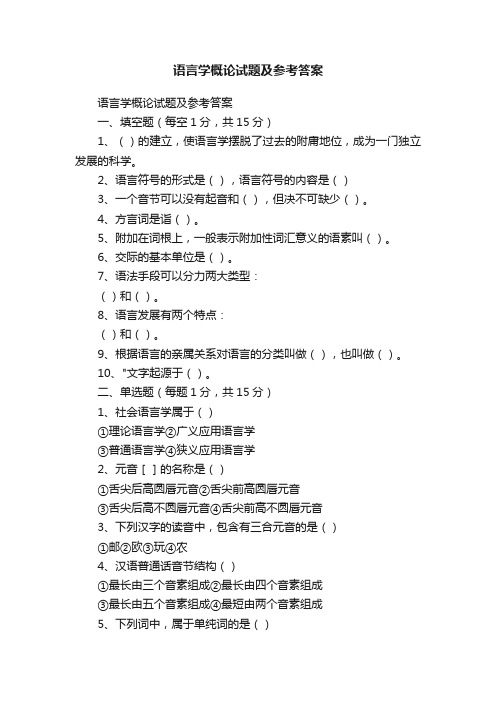
语言学概论试题及参考答案语言学概论试题及参考答案一、填空题(每空1分,共15分)1、()的建立,使语言学摆脱了过去的附庸地位,成为一门独立发展的科学。
2、语言符号的形式是(),语言符号的内容是()3、一个音节可以没有起音和(),但决不可缺少()。
4、方言词是诣()。
5、附加在词根上,一般表示附加性词汇意义的语素叫()。
6、交际的基本单位是()。
7、语法手段可以分力两大类型:()和()。
8、语言发展有两个特点:()和()。
9、根据语言的亲属关系对语言的分类叫做(),也叫做()。
10、"文字起源于()。
二、单选题(每题1分,共15分)1、社会语言学属于()①理论语言学②广义应用语言学③普通语言学④狭义应用语言学2、元音[]的名称是()①舌尖后高圆唇元音②舌尖前高圆唇元音③舌尖后高不圆唇元音④舌尖前高不圆唇元音3、下列汉字的读音中,包含有三合元音的是()①邮②欧③玩④农4、汉语普通话音节结构()①最长由三个音素组成②最长由四个音素组成③最长由五个音素组成④最短由两个音素组成5、下列词中,属于单纯词的是()①玻璃②黑扳③语言④红旗6、下列词中,属于复台词的是()①傻子②席子③天子④椅子7、下列词组中,属于多义的是()①两只学生送的花瓶②两位学生送的花瓶③两只学生送的花篮。
④两个学生送的花篮8、下列词中粗体的成分,属于同音关系的是()①杜鲁门——杜绝②负荆一负担③忽然--突然④花朵——浪花9、英语的‘foot”(脚,单数)变为“feet”(脚,复数)运用的语法手段是()①附加②异根③内部屈折④重叠10、"汉语普通话中的:“卡通片”中的“卡”是一个()①语素②音节③前缀④词11、"汉语中的:“了、着、过”在古代具有实实在在的词汇意义,到现代变成只1表语义的助词,这属于()①异化②类化③新语法范畴的形成④实词虚化12、"下列语言中属于粘着语的是()①苗语②越南语③俄语④日语13、"在一种语言内部划脑言时,最主要的依据是()①语法②语义③语音④词汇14、"下列词的词义,属于词义缩小的是()①“皮”原指兽皮②“涕”原指眼泪③“瓦”原指一切烧好的上器④“江”原捐“长江”15、"人类几种古老文字的原始字形,都是()①象形的②会意的③表音的④形声的三、多选题(在本题的每一小题的备选答案中,正确答案有三个或三个以上。
语言学问答题精选
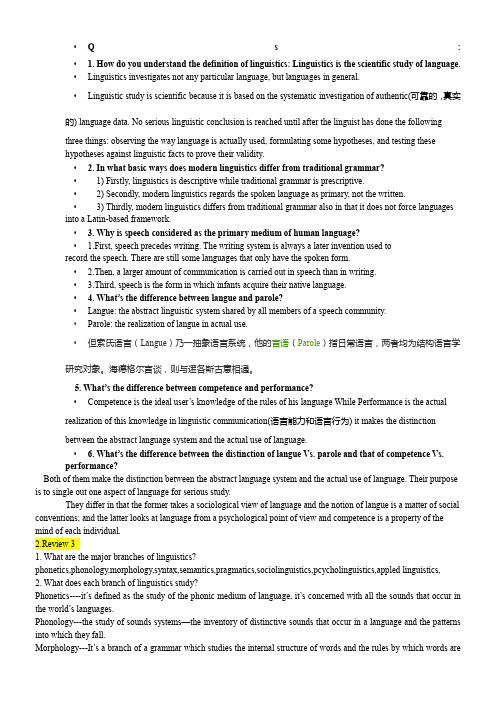
•Q s: • 1. How do you understand the definition of linguistics: Linguistics is the scientific study of language.•Linguistics investigates not any particular language, but languages in general.•Linguistic study is scientific because it is based on the systematic investigation of authentic(可靠的,真实的) language data. No serious linguistic conclusion is reached until after the linguist has done the followingthree things: observing the way language is actually used, formulating some hypotheses, and testing thesehypotheses against linguistic facts to prove their validity.• 2. In what basic ways does modern linguistics differ from traditional grammar?•1) Firstly, linguistics is descriptive while traditional grammar is prescriptive.•2) Secondly, modern linguistics regards the spoken language as primary, not the written.•3) Thirdly, modern linguistics differs from traditional grammar also in that it does not force languages into a Latin-based framework.• 3. Why is speech considered as the primary medium of human language?• 1.First, speech precedes writing. The writing system is always a later invention used torecord the speech. There are still some languages that only have the spoken form.• 2.Then, a larger amount of communication is carried out in speech than in writing.• 3.Third, speech is the form in which infants acquire their native language.• 4. What’s the difference between langue and parole?•Langue: the abstract linguistic system shared by all members of a speech community.•Parole: the realization of langue in actual use.•但索氏语言(Langue)乃一抽象语言系统,他的言语(Parole)指日常语言,两者均为结构语言学研究对象。
语言学问答题精选
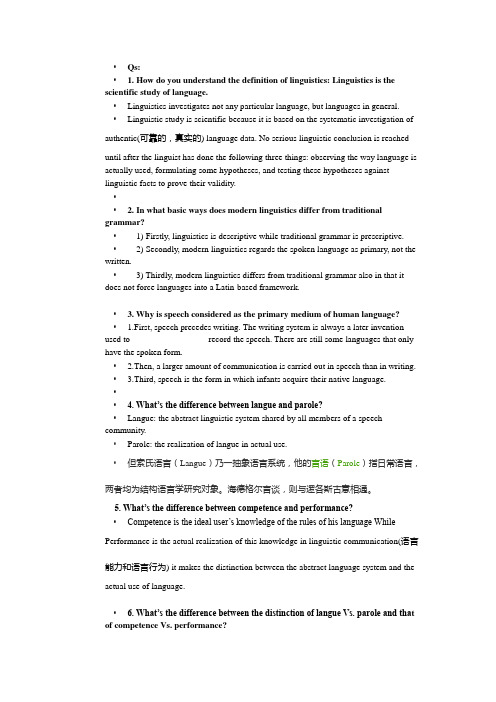
•Qs:• 1. How do you understand the definition of linguistics: Linguistics is the scientific study of language.•Linguistics investigates not any particular language, but languages in general. •Linguistic study is scientific because it is based on the systematic investigation of authentic(可靠的,真实的) language data. No serious linguistic conclusion is reacheduntil after the linguist has done the following three things: observing the way language is actually used, formulating some hypotheses, and testing these hypotheses against linguistic facts to prove their validity.•• 2. In what basic ways does modern linguistics differ from traditional grammar?•1) Firstly, linguistics is descriptive while traditional grammar is prescriptive. •2) Secondly, modern linguistics regards the spoken language as primary, not the written.•3) Thirdly, modern linguistics differs from traditional grammar also in that it does not force languages into a Latin-based framework.• 3. Why is speech considered as the primary medium of human language? • 1.First, speech precedes writing. The writing system is always a later invention used to record the speech. There are still some languages that only have the spoken form.• 2.Then, a larger amount of communication is carried out in speech than in writing. • 3.Third, speech is the form in which infants acquire their native language.•• 4. What’s the difference between langue and parole?•Langue: the abstract linguistic system shared by all members of a speech community.•Parole: the realization of langue in actual use.•但索氏语言(Langue)乃一抽象语言系统,他的言语(Parole)指日常语言,两者均为结构语言学研究对象。
语言学:语言学概论考试题(题库版)
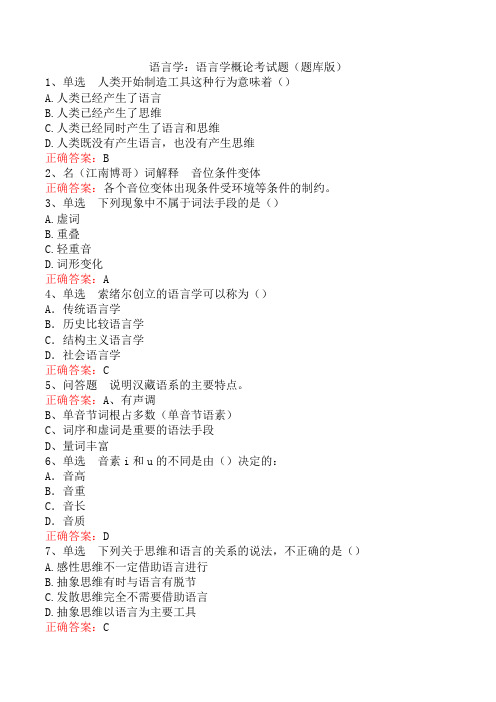
语言学:语言学概论考试题(题库版)1、单选人类开始制造工具这种行为意味着()A.人类已经产生了语言B.人类已经产生了思维C.人类已经同时产生了语言和思维D.人类既没有产生语言,也没有产生思维正确答案:B2、名(江南博哥)词解释音位条件变体正确答案:各个音位变体出现条件受环境等条件的制约。
3、单选下列现象中不属于词法手段的是()A.虚词B.重叠C.轻重音D.词形变化正确答案:A4、单选索绪尔创立的语言学可以称为()A.传统语言学B.历史比较语言学C.结构主义语言学D.社会语言学正确答案:C5、问答题说明汉藏语系的主要特点。
正确答案:A、有声调B、单音节词根占多数(单音节语素)C、词序和虚词是重要的语法手段D、量词丰富6、单选音素i和u的不同是由()决定的:A.音高B.音重C.音长D.音质正确答案:D7、单选下列关于思维和语言的关系的说法,不正确的是()A.感性思维不一定借助语言进行B.抽象思维有时与语言有脱节C.发散思维完全不需要借助语言D.抽象思维以语言为主要工具正确答案:C8、问答题论述语言学发展的历程?正确答案:语言学的发展同其他学科一样,经历了三个阶段:先是进行初步观察和内省思辩,然后是分清对象并加深观察和描写,最后才找出规律并形成理论体系。
从16世纪到18世纪,由于国际贸易的发展,西方国家的一些学者对外部世界的视野大大开阔了,懂得的语言和了解到的语言也大大增多了。
17世纪和18世纪不少人对各种不同语言的词语发生兴趣,纷纷搜集和编纂多语种的对照词表。
这时候有人发现欧洲和亚洲的有些语言之间有很多明显的相似之处,就开始加以比较研究,随后越来越多的人对欧洲和亚洲的一些语言进行比较研究。
最初的研究可以说直觉和猜想多于科学成分。
后来语言学吸取了控竽学和声学研究的成果,建立了科学的语音学,运用科学语音学的理论和方法逐步发现这些语言相互之间有严格的语音对应关系,而每一种语言本身自古以来的语音演变也有严格的语音演变规律,从而证明这些语言来源于相同的原始母语。
语言学问答题及答案
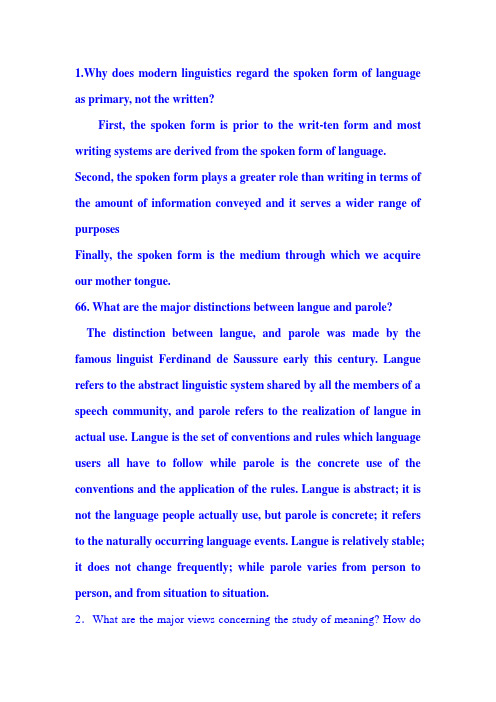
1.Why does modern linguistics regard the spoken form of language as primary, not the written?First, the spoken form is prior to the writ-ten form and most writing systems are derived from the spoken form of language. Second, the spoken form plays a greater role than writing in terms of the amount of information conveyed and it serves a wider range of purposesFinally, the spoken form is the medium through which we acquire our mother tongue.66. What are the major distinctions between langue and parole?The distinction between langue, and parole was made by the famous linguist Ferdinand de Saussure early this century. Langue refers to the abstract linguistic system shared by all the members of a speech community, and parole refers to the realization of langue in actual use. Langue is the set of conventions and rules which language users all have to follow while parole is the concrete use of the conventions and the application of the rules. Langue is abstract; it is not the language people actually use, but parole is concrete; it refers to the naturally occurring language events. Langue is relatively stable; it does not change frequently; while parole varies from person to person, and from situation to situation.2.What are the major views concerning the study of meaning? How dothey differ?One of the oldest was the naming theory, proposed by the ancient Greek scholar Plato, who believed that the words used in a language are taken to be la-bels of the objects they stand for. The conceptualist view holds that there is no direct link between a lin-guistic form and what it refers to. The form and the meaning are linked through the mediation of concepts in the mind. Contextualism is based on the presumption that one can derive meaning from or reduce meaning to observable contexts. Two kinds of context are recognized; the situational context and the linguistic context.For example, the meaning of the word "seal" in the sentence "The seal could not be found" can only be determined ac-cording to the context in which the sentence occurs:The seal could not be found. The zoo keeper became worried.(seal meaning an aquatic mammal)The seal could not be found. The king became worried.(seal meaning the king's stamp)Behaviorism drew on behaviorist psychology when he tried to define the meaning of linguistic forms. Behaviorists attempted to de-fine the meaning of a language form as " the situation in which the speaker utters it and the response it calls forth in the hearer".3.Discuss with examples some of the linguistic differences between Standard English and Black English.One of the most prominent phonological characteristics of Black English is the frequent simplification of consonant clusters at the end of words when one of the two consonants is an alveolar /t/, /d/, /s/, or /z/. The application of this simplification rule may delete the past - tense morpheme, so "past "and "passed "are both pronounced like "pass."Another salient characteristic of Black English phonological system con-cerns the deletion of some word-final stop consonants in words like "side" and "borrowed." Speakers of Black English frequently delete these word-fi-nal stops, pronouncing “side” like “sigh” and “borrowed” like “borrow.”One prominent syntactic feature is the frequent absence of various forms of the copula "be" in Black English, which are required of Standard Eng-lish. Compare the following expressions in Black English and Standard Eng-lish:(1) Black English Standard EnglishThey mine. They' re mine.You crazy. You re crazy.Another distinctive syntactic feature of Black English is the systematic use of die expression "it is" where Standard English uses "there is " in the sense of “there exists” :Is it a Mr. Johnson in this office?Another aspect of Black English is the use of double negation constructions. Whenever the verb is negated, the indefinite pronouns "something", "some-body", and "some" become the negative indefinites "nothing", "nobody", and "none", for example:He don't know nothing. (He doesn't know anything.)4.How does a sentence meaning differ from an utterance meaning?A sentence meaning is of-ten considered as the intrinsic property of the sentence itself in terms of a predication. It is abstract and independent of context. The meaning of an utterance is concrete, and context-dependent. The utterance meaning is based on sentence meaning; it is realization of the abstract meaning of a sentence in a real situation of communication, or simply in a context. For example, “There is a dog at the door”. The speaker could utter it as a matter- of- fact state-ment, telling the hearer that the dog is at the door. The speaker could use it as a warning, asking the hearer not to approach the door. There are otherpossibilities, too. So, the understanding of the utterance meaning of “There is a dog at the door” de-pends on the context in which it is uttered and the purpose for which the speaker utters it.。
语言学全部习题
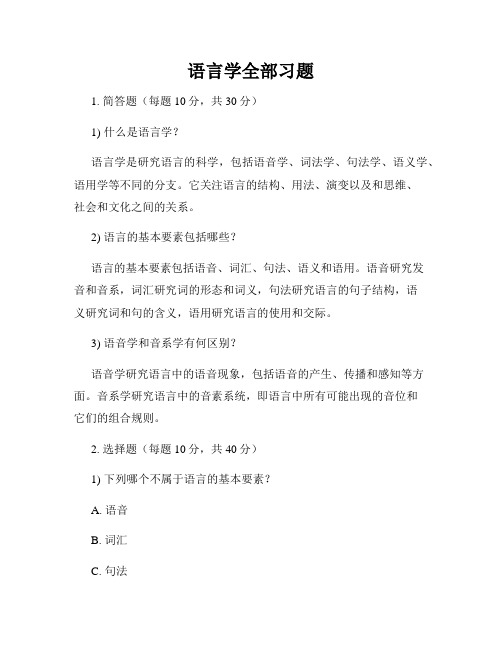
语言学全部习题1. 简答题(每题10分,共30分)1) 什么是语言学?语言学是研究语言的科学,包括语音学、词法学、句法学、语义学、语用学等不同的分支。
它关注语言的结构、用法、演变以及和思维、社会和文化之间的关系。
2) 语言的基本要素包括哪些?语言的基本要素包括语音、词汇、句法、语义和语用。
语音研究发音和音系,词汇研究词的形态和词义,句法研究语言的句子结构,语义研究词和句的含义,语用研究语言的使用和交际。
3) 语音学和音系学有何区别?语音学研究语言中的语音现象,包括语音的产生、传播和感知等方面。
音系学研究语言中的音素系统,即语言中所有可能出现的音位和它们的组合规则。
2. 选择题(每题10分,共40分)1) 下列哪个不属于语言的基本要素?A. 语音B. 词汇C. 句法D. 语文答案:D2) 以下哪个学科不是语言学的分支?A. 语音学B. 语用学C. 数学D. 词法学答案:C3) 语音学主要研究哪方面的内容?A. 词义B. 词形C. 词语的使用D. 语音的产生和感知答案:D4) 以下哪个不是语言学的研究对象?A. 词汇表B. 句子结构C. 语言和思维的关系D. 社会语言规范答案:A3. 简答题(每题10分,共30分)1) 什么是语言的演变?语言的演变是指语言在使用过程中,由于多种因素的影响,其语音、词汇、句法等方面发生变化和发展。
语言的演变是一个长期的、渐进的过程,涉及到语言交流者的语言习惯、语音产生的方式、语法规则的改变等方面的变化。
2) 语言和思维之间有何关系?语言和思维之间有密切的关系。
一方面,语言是人类思维的表达工具,通过语言的运用,人们能够将思维中的概念、情感和意图等传递给他人。
另一方面,语言也影响思维的方式和内容。
语言结构和词汇的差异会影响人们的思维方式,不同语言对概念的划分和认知方式可能会有所不同。
3) 什么是语言交际?语言交际指的是人们通过语言进行沟通和交流的过程。
语言交际包括语言的使用、理解和解释,以及交流中的非语言行为和语境等因素。
“语言学概论”问答题列举

“语言学概论”问答题列举1、语言对于人类社会的重要意义主要体现在哪些方面?答:(1)语言是人类社会的交际工具,是组成社会不可缺少的因素,是人与人之间互相联系的纽带,没有语言,社会就会解体,不复存在。
(2)语言是人类最重要的交际工具,人类有各种各样的交际工具,如文字、旗语、电报、电话等,但它们都建立在语言基础之上的。
(3)语言是人类的思维工具,思维离不开语言,必须在语言材料的基础上进行。
2、为什么说荀子的“约定俗成”四个字道出了语言符号的本质?答:①语言符号的语音形式和意义内容之间没有必然的、本质的联系,完全是任意的。
(2分)②用什么样的声音形式表达什么样的意义,什么样的意义用什么样的语音表达,是由社会全体成员共同约定并共同遵守的。
荀子的“约定俗成”观点,说明了语言音义之间的联系不是天然的,而是社会成员约定的,说明了语言实际上就是一种约定的符号,反映了音义联系的实质。
(4分)3、语言没有阶级性,从哪些地方可以看出来?语言有没有阶级性?为什么?答:①语言是人类最重要的交际工具,也是一个社会全体成员共同的交际工具,一视同仁地为社会成员服务,没有阶级之分。
(3分)②语言的构成成分也没有阶级性,比如语言的语音、语法结构、词汇系统等,都没有阶级之分,是各个阶级的人都要使用的。
(3分)4、为什么说语言是一种特殊的社会现象?答:①所谓社会现象是指那些与人类共同体的产生、存在和发展等活动密切联系的现象,语言就是一种社会现象。
(2分)②语言又是一种特殊的社会现象。
社会现象可分为上层建筑和经济基础两大类,任何一种社会现象,或者属于上层建筑,或者属于经济基础,而语言既不属于上层建筑,也不属于经济基础,具有全民性,没有阶级性,一视同仁地为社会全体成员服务。
所以语言是特殊的社会现象。
(4分)5、语言是社会现象还是自然现象?说说你的看法。
答:①语言从本质上说是社会的,具有社会性。
一个社会是一定的经济基础和上层建筑构成的整体。
语言学问答题、名词解释
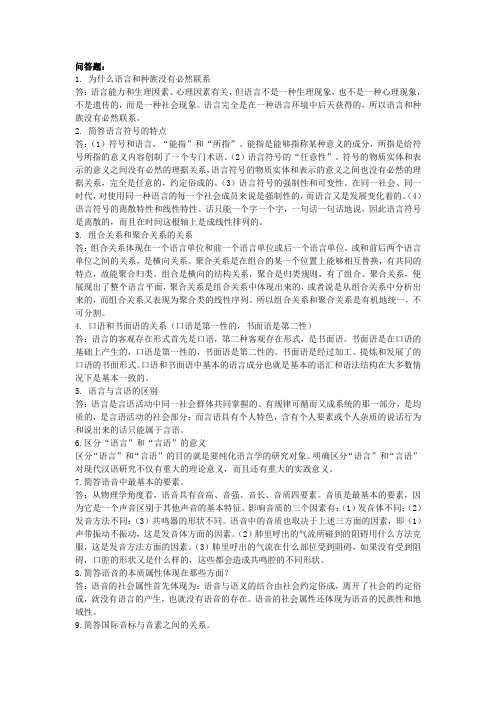
问答题:1. 为什么语言和种族没有必然联系答:语言能力和生理因素、心理因素有关,但语言不是一种生理现象,也不是一种心理现象,不是遗传的,而是一种社会现象。
语言完全是在一种语言环境中后天获得的,所以语言和种族没有必然联系。
2. 简答语言符号的特点答:(1)符号和语言,“能指”和“所指”。
能指是能够指称某种意义的成分,所指是给符号所指的意义内容创制了一个专门术语。
(2)语言符号的“任意性”。
符号的物质实体和表示的意义之间没有必然的理据关系,语言符号的物质实体和表示的意义之间也没有必然的理据关系,完全是任意的,约定俗成的。
(3)语言符号的强制性和可变性。
在同一社会、同一时代,对使用同一种语言的每一个社会成员来说是强制性的,而语言又是发展变化着的。
(4)语言符号的离散特性和线性特性。
话只能一个字一个字,一句话一句话地说,因此语言符号是离散的,而且在时间这根轴上是成线性排列的。
3. 组合关系和聚合关系的关系答:组合关系体现在一个语言单位和前一个语言单位或后一个语言单位,或和前后两个语言单位之间的关系,是横向关系。
聚合关系是在组合的某一个位置上能够相互替换,有共同的特点,故能聚合归类。
组合是横向的结构关系,聚合是归类规则,有了组合、聚合关系,便展现出了整个语言平面,聚合关系是组合关系中体现出来的,或者说是从组合关系中分析出来的,而组合关系又表现为聚合类的线性序列。
所以组合关系和聚合关系是有机地统一,不可分割。
4. 口语和书面语的关系(口语是第一性的,书面语是第二性)答:语言的客观存在形式首先是口语,第二种客观存在形式,是书面语。
书面语是在口语的基础上产生的,口语是第一性的,书面语是第二性的。
书面语是经过加工、提炼和发展了的口语的书面形式。
口语和书面语中基本的语言成分也就是基本的语汇和语法结构在大多数情况下是基本一致的。
5. 语言与言语的区别答:语言是言语活动中同一社会群体共同掌握的、有规律可循而又成系统的那一部分,是均质的,是言语活动的社会部分;而言语具有个人特色,含有个人要素或个人杂质的说话行为和说出来的话只能属于言语。
语言学概论复习问答题_百度文库

第一章语言的社会功能1. 什么是语言?从语言学的角度看,我们主要侧重于从语言的社会功能角度来认识考察语言。
从语言的社会功能看,人类语言虽然多种多样,但归结起来功能都是相同的,即作为交际工具和思维工具。
按照我们的教材给语言下一个定义就是;语言是人类最重要的交际工具,也是思维的工具。
2. 语言的作用是什么,举例说明。
1 语言是人类最重要的交际工具。
人类传递信息,进行交际和交流思想,除了使用语言外,还可以使用文字、旗语、红绿灯、电报代码、数学符号以及身势、表情等,在一定场合使用,可以弥补语言的一些不足,但是这些交际工具使用范围有限,有的仅用于特定的范围,最重要的是,这些交际工具,都离不开语言,都是在语言的基础上产生的,是辅助语言进行交际的,没有语言,这些手段的存在没有任何意义。
(即为什么说语言是人类最重要的交际工具。
2 语言是人类的思维工具。
语言不但是人类的交际工具,同时也是人类思维的工具,是认识成果的贮存所。
思维过程离不开语言,需要借助语言来进行比较、分析、综合等一系列活动,需要借助语言来形成思想,利用语言把它储存在头脑中,再借助语言把思想表达出来,传达给听话人,同时使听话人产生思想。
而且人类思维的成果-概念,还可以通过词语固定下来。
总之,思维活动的过程不可能离开语言而单独进行,思维离不开语言,必须借助语言材料才能进行。
语言也离不开思维,二者是互相依存,共同发展的。
(即语言和思维的关系3. 怎样认识理解语言和说话的关系?语言是社会全体成员共同使用的交际工具,说话是使用这种交际工具的行为,说出来的话语则是使用这种交际工具所产生的结果。
1 借助哲学上的观点来认识,语言和说话其实就是一般和特殊的关系。
语言就是一般的事物,说话就是特殊的、个别的事物。
属于语言的一切都是概括的,一般的,反映共性的东西,属于说话的一切都是具体的、个别的、特殊的。
因为说话总是和具体的环境密切地联系在一起的,话语中的任何词语反映的任何概念,都是具体有所指的。
语言学纲要综合问答题
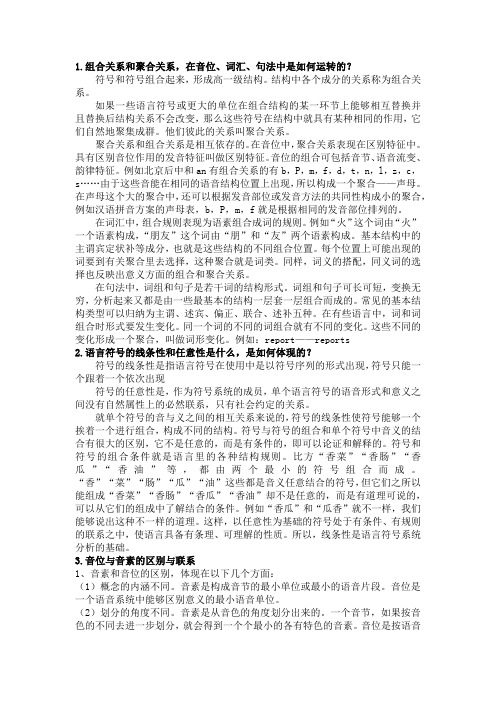
1.组合关系和聚合关系,在音位、词汇、句法中是如何运转的?符号和符号组合起来,形成高一级结构。
结构中各个成分的关系称为组合关系。
如果一些语言符号或更大的单位在组合结构的某一环节上能够相互替换并且替换后结构关系不会改变,那么这些符号在结构中就具有某种相同的作用,它们自然地聚集成群。
他们彼此的关系叫聚合关系。
聚合关系和组合关系是相互依存的。
在音位中,聚合关系表现在区别特征中。
具有区别音位作用的发音特征叫做区别特征。
音位的组合可包括音节、语音流变、韵律特征。
例如北京后中和an有组合关系的有b,P,m,f,d,t,n,l,z,c,s……由于这些音能在相同的语音结构位置上出现,所以构成一个聚合——声母。
在声母这个大的聚合中,还可以根据发音部位或发音方法的共同性构成小的聚合,例如汉语拼音方案的声母表,b,P,m,f就是根据相同的发音部位排列的。
在词汇中,组合规则表现为语素组合成词的规则。
例如“火”这个词由“火”一个语素构成,“朋友”这个词由“朋”和“友”两个语素构成。
基本结构中的主谓宾定状补等成分,也就是这些结构的不同组合位置。
每个位置上可能出现的词要到有关聚合里去选择,这种聚合就是词类。
同样,词义的搭配,同义词的选择也反映出意义方面的组合和聚合关系。
在句法中,词组和句子是若干词的结构形式。
词组和句子可长可短,变换无穷,分析起来又都是由一些最基本的结构一层套一层组合而成的。
常见的基本结构类型可以归纳为主谓、述宾、偏正、联合、述补五种。
在有些语言中,词和词组合时形式要发生变化。
同一个词的不同的词组合就有不同的变化。
这些不同的变化形成一个聚合,叫做词形变化。
例如:report——reports2.语言符号的线条性和任意性是什么,是如何体现的?符号的线条性是指语言符号在使用中是以符号序列的形式出现,符号只能一个跟着一个依次出现符号的任意性是,作为符号系统的成员,单个语言符号的语音形式和意义之间没有自然属性上的必然联系,只有社会约定的关系。
- 1、下载文档前请自行甄别文档内容的完整性,平台不提供额外的编辑、内容补充、找答案等附加服务。
- 2、"仅部分预览"的文档,不可在线预览部分如存在完整性等问题,可反馈申请退款(可完整预览的文档不适用该条件!)。
- 3、如文档侵犯您的权益,请联系客服反馈,我们会尽快为您处理(人工客服工作时间:9:00-18:30)。
1.How are the English consonants classified
English consonants can be classified in two ways: one is in
terms of manner of articulation and the other is in terms of
place of articulation.
2.How can words opposite in meaning be classified To which
category does each of the following pairs of antonyms belong
Deep ----shallow married---single sour---sweet
Teacher---student asleep--- awake
They can be gradable antonyms, complementary antonyms and
relational opposite .
3. Discuss in detail the locutionary act, illocutionary act
and perlocutionary act.
A locutionary act is the act of uttering words, phrases,
clauses. It is the act of conveying literal meaning by means
of syntax, lexicon and phonology. An illocutionary act is the
act of expressing the speaker's intention; it is the act
performed in saying something. A perlocutionary act is the act
per-formed by or resulting from saying something; it is the consequence of, or the change brought about by the utterance;
it is the act performed by saying something.
4.What is an inflectional morpheme Locate the inflectional morpheme in each of the following sentences and point out its grammatical meaning.
Mr. Smith lives in the Big Apple.
The film’s already started.
There are bound morphemes which are for the most part purely grammatical makers and signify such concepts as tense,number,case and bound morphemes are called inflectional morphemes.
with examples the three notions of phone, phoneme and allophone, and also how they are related.
(1)A phone is a speech sound, it is phonetic unit. Any sound we hear in the course of communication s a phone, such as /u:/, /l/, /p/, /p’/.
(2)A phoneme is a phonological unit. It is not a concrete sound
but an abstract notion. It is a collection of features. It can be realized as different phones in different phonetic contexts. Foe example, the phoneme/l/ can be realized as a clear [l] or
a dark [l], depending on where it occurs in a sound combination.
(3)The actually phonetic realizations of a phoneme are called its allophones. Allophones are the actual phones we hear in linguistic communication.
6. What are the four maxims of the CP Try to give your own examples to show how flouting these maxims gives rise to conversational implicature
Cooperative Principle, abbreviated as CP. It goes as follows: Make your conversational contribution such as required at the stage at which it occurs by the accepted purpose or direction of the talk exchange in which you are engaged.
To be more specific, there are four maxims under this general principle:
(1) The maxim of quantity
① Make your contribution as informative as required (for the
current purpose of the
exchange).
② Do not make your contribution more informative than is required.
(2) The maxim of quality
① Do not say what you believe to be false.
② Do not say that for which you lack adequate evidence.
(3) The maxim of relation
Be relevant.
(4) The maxim of manner
① Avoid obscurity of expression.
② Avoid ambiguity.
③ Be brief (avoid unnecessary prolixity).
④ Be orderly.。
